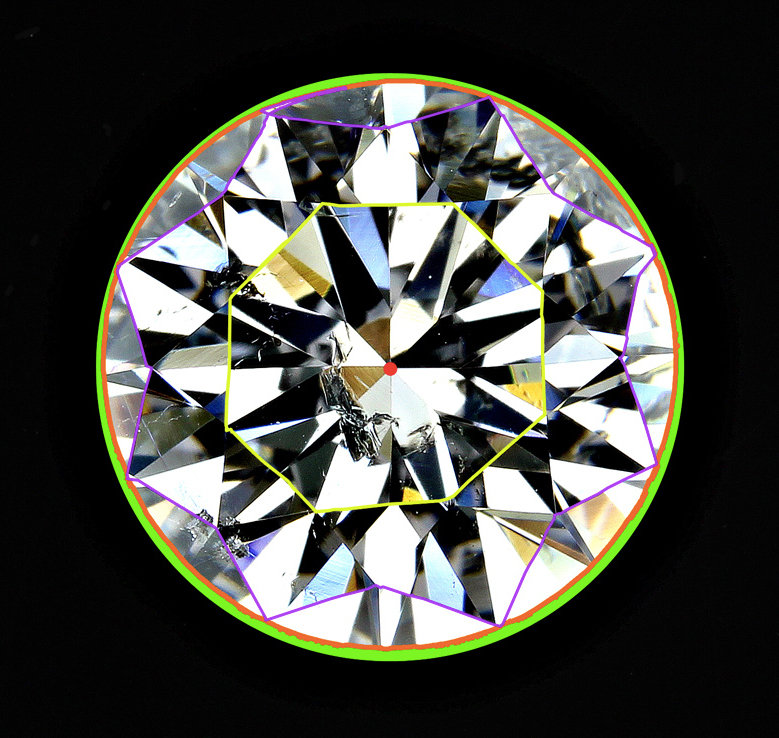Symmetry refers to the exactness of the shape and arrangement of facets in a diamond.
Although to the naked eye polish has only a small effect on appearance, symmetry
has a significant effect.

Green – perfect round
Orange – the stone Out of round
Purple - Misshapen Facets
Yellow – None octagonal table
Red - Culet Off-Center
Yellow + Red - Table Off-Center & Table & Girdle Misalignment
Crown & Pavilion Misalignment – In a round diamond the top points
of the pavilion mains and the bottom points of the bezel facets should meet precisely
at the girdle.
Table & Girdle Misalignment - - the table is not parallel with
the girdle. As you see, the crown angle is much steeper on one-side versus the other.
From the top view you may have noticed an off-center table.
Misshapen Facet - A correct table displays a regular octagonal
shape. It should have eight sides of equal length that are each parallel to the
opposing opposite facet. In this example we see facets that are not the same size
and shape as others like them on the face of the diamond.
T/OC Table Off-Center The placement of the table (the largest facet
on a diamond) should be centered at the top of the stone and needs to be parallel
to the girdle. If the table is off-center or not parallel with the girdle this can
cause uneven crown angles from one side to the other.
C/OC Culet Off-Center - To check if the culet is centered look
at the diamond in the face-up position. You'll see the lower girdle facets through
the table. If the lines formed by them look like a perfect square, the culet is
centered. If the cross bends one way or the other, the culet is not centered. In
this example we see what an off-centered culet might look like
Extra Facets -These are typically located on the pavilion, near
the girdle, but they can be found anywhere on a diamond. In this example we see
where extra facets commonly occur.
Crown Height verification– Contrary crown height measurement may
indicate about a wavy girdle or crown – pavilion misalignment.
Crown angel verification – Unequal crown angel measurement may
indicate a wavy girdle or crown – pavilion misalignment.
Pavilion Depth verification – dissimilarities in pavilion depth
is a sign of a wavy girdle.
Pavilion angel verification – Differing crown angel indicate for
culet of center (COC).
Wavy Girdle - The girdle of a diamond should be a flat plane, parallel
to the table. In this example the girdle "waves" as it wraps
around the diamond.
Faces not Pointing Up - Some diamonds display facets that are not
properly pointed. Facet patterns of round brilliants are meant to show a precise
arrangement of 58 perfectly shaped facets. In this example we see some that some
do not meet at a direct point.
Naturals on Crown and Pavilion - A natural is the original "rough"
of the diamond. Naturals always occur or start out on the girdle. They either dip
towards the pavilion or the crown. In this example we see the natural located on
the girdle running down into the pavilion.